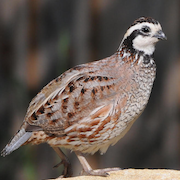From the Executive Director, Adam R. Moore
Bob…WHITE!
A bobwhite? Could it be? Startled, I stopped my work and sat still for a moment.
Then, again: Bob…WHITE!
“A bobwhite!” I exclaimed, and dashed out the door to listen. In all my years of living at Quansoo, I had never heard a bobwhite calling – until today. Then, again, came the call, utterly unmistakeable, loud as a church bell, ringing across the great green grassy plain: Bob…WHITE!
Though now uncommon, bobwhite quail were once plentiful across the meadows of Quansoo and Quenames and the southshore of Martha’s Vineyard. The bobwhite’s namesake call (bob…WHITE!) once played, and now may continue to play, a signature role in the symphony of sounds that signify an Island spring.
When one considers spring, one most often considers a progression of vernal sights. At Quansoo, spring appears later than it does around the rest of the Island. By Mother’s Day the shadbush blossoms, and its delicate white flowers adorn the length of each ancient dirt road. After that the sassafras breaks bud, with starbursts of bright green leaves at the end of each twig. Huckleberry blossoms, and then leafs out, and turns the entire forest floor into a bristling carpet of green. Last are the oak tree leaves, which start to emerge around Memorial Day, first red, and then turning to green.
Yet just as there is a progression of these sights of spring, so also is there a progression of sounds. On Martha’s Vineyard, spring begins definitively with the evening call of the pinkletink. Pinkletink is a name that is peculiar to the Island, as everywhere else these tree frogs are called spring peepers. On cold nights in early March, I can hear their amphibious chorus ring out from a stand of oaks off some distance to the west, along the Black Point Road.
Next come the ospreys. The ospreys nest atop a pole set beside the so-called “picnic woods.” They arrive sometime in March, and immediately set to work adding sticks and roots and bits of rope to their massive, ragged eyrie. When not fixing the nest or fishing, the osprey call to each other with a loud and incessant series of peeps. After the osprey, a vast number of birds arrive. Each bird emits its own distinct song or chirp, as each tries to attract a mate, or defend territory, or communicate with its fellows. At the summer solstice, the days are at their longest. The sun lingers as it sets, and the twilight melts into the June evening. On these nights, one hears the call of the whippoorwill. When the whippoorwill calls, I step outside for a spell, to listen to this distinctive coda of the season.
That these sounds of spring may be heard at Quansoo, and across the island of Martha’s Vineyard, is due to the decades of work by Sheriff’s Meadow Foundation and our conservation colleagues. By conserving land, we allow places for nature to sing out,
unmuffled.
And to this springtime symphony, this year the bobwhite joined in. It has long been my hope that Sheriff’s Meadow Foundation’s management of Quansoo, and of the meadows and heathlands of the nearby Priscilla Hancock Meadow and Wade’s Field, would provide suitable habitat for the bobwhite quail.
Perhaps this is now the case? When I walk the paths of Quansoo in September, might I spy a mother bobwhite trailed by a covey of chicks? Time shall tell.
In the meantime, just listen: bob-WHITE!
Adam R. Moore
Executive Director
Thank you David Damroth for the bobwhite quail photograph.



